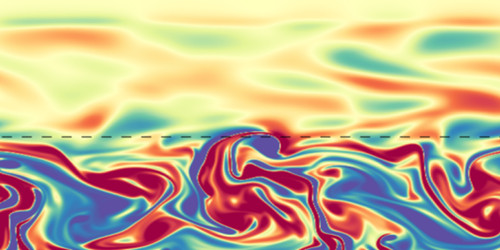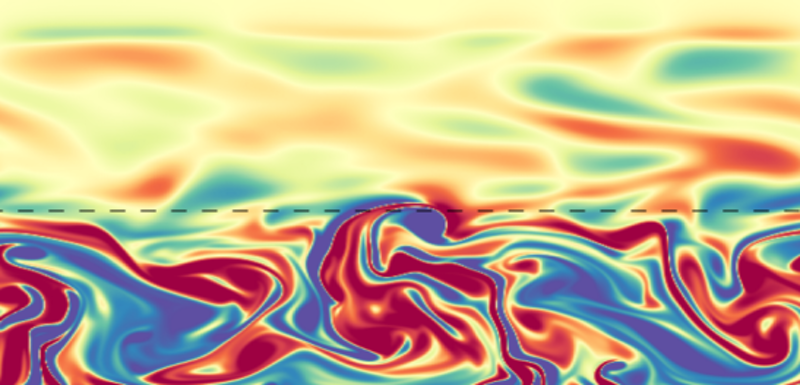Puzzling Tropical Wind Pattern Generated with Simple Model
Atmospheric scientists have been perplexed for decades about the origin of global winds that flow around the Earth’s equator and reverse direction every 14 months or so. Now a computer simulation of a simplified atmospheric model has shown that similar, large-scale reversing flows should get stirred up naturally by turbulent motions on much smaller scales in the atmosphere. The work could greatly improve the modeling of fluid flows in planetary atmospheres and in the interiors of stars.
Computers aren't fast enough to simulate the fluid flows on planets and inside stars down to the level of each tiny vortex. Instead, simulations break space up into discrete pieces. In current models of the Earth's atmosphere, these chunks are about 10 km across, so the models don't include smaller-scale phenomena such as local eddies, even though such processes can feed upward to have important consequences at much larger scales.
To compensate, modelers typically try to include the small-scale influences in an approximate way, capturing their effects by modifying the fluid equations. But the accuracy of the resulting simulations depends strongly on these approximations. For example, researchers have long worried about the potential for turbulent flows on small scales to generate significant, steady flows on much larger scales, such as planet-scale prevailing winds. This kind of influence is not included in most approximations. Inspired by the observation of enigmatic large-scale flows in the Earth’s atmosphere, Louis-Alexandre Couston of Aix-Marseille University in France and colleagues set out to see if small-scale turbulence might have a general tendency to drive such flows.
They studied a simplified mathematical model describing a vertical, two-dimensional slice through the atmosphere oriented along a line of latitude. In this model, there are rigid walls at the top and bottom edges, and air flowing out of the slice through the left or right side reappears at the opposite side. A fixed, high temperature is maintained at the bottom wall and a low temperature at the top wall. This setup, along with an appropriate temperature-density relationship for air, causes the gas to stratify into two zones—a warmer zone of turbulent flow below and a cooler zone with smoother flow above.
Although this model is unrealistic in several ways, researchers think it reproduces the essential elements of the Earth’s atmosphere, with its troposphere below and stratosphere above. A key advantage of the model, says Couston, is that it can capture both turbulent fluid motions on small scales and steady flows on large scales. The model can also be run for a long time, to study how the small and large scales influence one another.
Over long times, the team’s simulations revealed a general pattern: small-scale turbulent motions in the lower zone create disturbances at the interface between the two regions, which generate waves traveling in all directions in the upper zone. These waves then interact with each other and feed energy into an average, large-scale flow, which slowly oscillates between a roughly westward and a roughly eastward motion of air.
These simulations are the first to show that an oscillating mean flow can emerge from waves driven by turbulence, says Couston. “It's only because we ran the simulations for long times that we could see the influence between scales,” he says.
Other experts in atmospheric dynamics say that the idea that small-scale turbulent flows at lower levels in the atmosphere can drive coherent large-scale flows at higher levels has been understood empirically for two decades. But seeing it happen in a full simulation is new. “The real world is not two-dimensional,” says meteorologist François Lott of the École Normale Supérieure in Paris, “but the results they find in this model with all the scales explicitly resolved are quite novel.”
Couston suggests that this finding may stimulate a change in modeling strategy for planetary atmospheres, climate, stars, and liquid planetary interiors. For example, most climate models currently try to account for neglected small-scale effects by applying extra, constant-in-time forces to drive larger-scale flows. But this forcing should be periodic in time—in a way that can now be unraveled with the help of the new simulations—to produce realistic, large-scale oscillations. The simplicity of the model implies that this effect is very general, says Couston. The transfer of energy from small to large scales should happen in essentially any stratified fluid flow.
This research is published in Physical Review Letters.
–Mark Buchanan
Mark Buchanan is a freelance science writer who splits his time between Abergavenny, UK, and Notre Dame de Courson, France.





